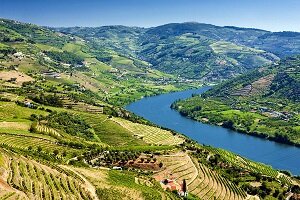Gateway
Douro, Portugal
About Gateway
Sustainably Farmed
Douro is a Portuguese wine region located around the Douro River, upstream, east of the city of Porto. It is sheltered from the coast by a mountain range. The region has Portugal's highest wine classification as a Denominação de Origem Controlada (DOC). While the region is primarily associated with Port wine production, Douro produces just as much table wine as it does fortified wine. The non-fortified wines are referred to as "Douro wines".
There is archaeological evidence for winemaking in the region dating from the end of the Western Roman Empire, during the 3rd and 4th centuries A.D. In the 17th century, the region's vineyards expanded, and the earliest known mention of "Port wine" dates from 1675. Following the establishment of many British Port lodges in Porto from the 1700’s, Port wine became the primary product traded from the region. From September 1756 a charter was established to define the production area and regulations for Port wine. As a result, it became the world's first wine region to have a formal geographical demarcation.
While table wine has always been produced in the region, it was solely consumed locally until the 1950’s when wine began to be traded outside the area. While the wines could be good, for a long time, there was no attempt to use Douro grapes to produce more ambitious table wine. It is not however until the 1990’s that a large number of quality table wines made their appearance outside the Douro border. A contributing factor was Portugal's entry into the European Economic Community in 1986.
Vinho Verde is a semi-sparkling Portuguese wine whose name literally means ‘green wine’, referring to the fact that it is a ‘young wine’ and not to its color. The grapes are picked relatively young and Vinho Verde maybe a white, Rose, red or sparkling wine called Espumante.
Gateway is a traditional style of Vinho Verde, low in alcohol with a slight fizz and a lot of freshness; it is made from a blend of Trajadura, Loureiro, Arinto and Azal and comes from the Amarante sub-region.

